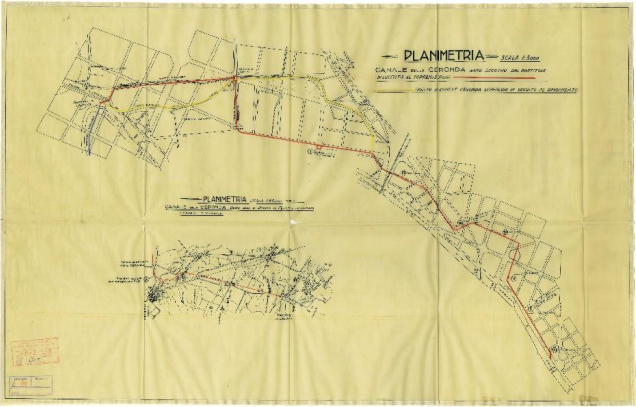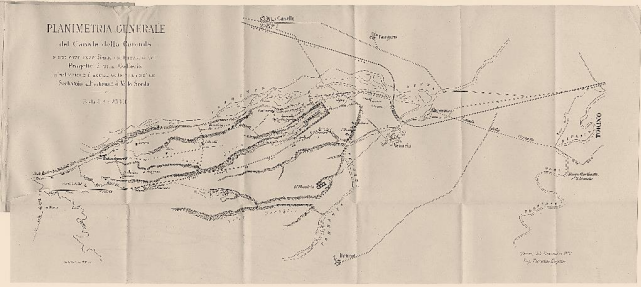The Ceronda stream
Named Ceronda (“srunda” in Piedmontese language) from the ancient name “clear waves”, the stream is formed from springs that flow from Colombano Mount, which is 22Km long, it crosses villages and countryside, it settles at the edges of La Mandria Park and with soft volutes it reaches Vanaria Reale, to pour out, somewhere placidly somewhere impetuously, into the Stura of Lanzo. Sharp eyes can observe along its banks white and grey herons, wild ducks, otters and cormorants, sometimes also seagulls in flight in the colors of nature. The river may look like it has its own character, its own passions: it’s often placid and almost quiet; however it sometimes feels mad, totally unchained to the point of wreaking havoc. A stream feared and loved by the inhabitants of Vanaria, who are always apprehensive during the floods, but ready to frequent its sides at quieter times, to fish with a rod, walk on foot or cycle along its blanks, to throw stones into the water, to…some brief and secretive love meetings.
The Ceronda canal
The most ancient example of water use of Ceronda canal to generate motive force is located in Altessano. Here the Barolo Marquis dug a 5 metres wide and 300 metres long canal to power their mill. Starting from this canal engineer Borella started ”the Ceronda Canal”, set up on 5th May 1868 with prefectural decree. The canal was supposed to give motive force to the manufactures already present in the northern area of Turin, but it also helped promoting and incentivizing the industrial development of the city after the economic crisis due to the transfer of the capital to Florence in 1864. From Altessano, following a 4km long underground route, it comes out nearby the Borgata Lucento church, where it branches out into two sections: one on the left, inaugurated in 1871, which is used to turn the wheels, continues on the hydrographic left of the Dora Riparia then enters the same river; the other one, on the right, completed in 1873, remaining under the Dora river crosses it with a canal bridge, and continues until it pours out in the Po river. The waters of this branch were once used for washing the drainage system, for cleaning the streets from snow and for the firefighting service.
The Ceronda basin
The Ceronda basin lies between the glacial-fluvial conoids of the Dora Riparia and of the Stura of Lanzo, a land with an area of almost 170Km2. The head of the basin is set on highlands overlooking the Turinese lowland that culminate in the Druina (1.516 m), Colombano (1.658 m) and Arpone (1.600 m) mountains. The mountainous portion (about half of the basin) is drained by the Ceronda and Casternone streams. The valleys are short and steep and the annual rainfall averages go from over 1.300mm in the mountains to 1.000mm in the plains. The Ceronda flows, in its terminal section, in the town of Venaria Reale, into the Stura of Lanzo. Originally, the name of this waterway was maybe “Clara Onda”, meaning “Clear Wave” in Latin: the first signs of settlements on the riverbed are in fact Romans. Later, in the Middle Ages, the fusion between the two words in “Claronda”, then in “Chiaronda”occured, as it may be seen in the writings of Amedeo di Castellamonte, dedicated to Carlo Emanuele II, concerning the project of the Reggia di Diana in Venaria. Since then the toponym has changed into the current “Ceronda” through the Piedmontese dialect “Ciaira Onda”. The Ceronda not only constitues an interesting biological and morphological natural system, but it has heavy historical and landscape value. In fact, Amedeo di Castellamonte wrote: “…the river Chiaronda flows…quickly with waters whose name does not lie and well far from the city so that it doesn’t inconvenience the inhabitants. In fact, it grants the landscape beauty and delight.”
The Ceronda canal
To compensate the city of Turin for the loss of the capital, the Parliament, with the Law of 18/12/1864, placed at the disposal of the city an annual pension of £300.00, so it could adopt a new canal . Eight projects were introduced among which engineer Borella’s ”The Ceronda Canal” was chosen. At the time the denizens of Turin thought that the inhabitants of Venaria wanted the waters to wash away the “blood of September”, referring to the Turinese upheavals of 1864, caused by the removal of the capital from Turin to Florence. However only with the realization of the Ceronda Canal the real industrial development of Turin took place. The ”Ceronda Canal” had a discharge of 4.000 litres/minute (increased by” the Clear Water Canal”, a catchment in the sub-bed of the right of the Stura that ran along the railway and crossed the riverbed of the Ceronda with a siphon to enter the homonymous canal just downstream of the railway station) and developed, originally, 849H.P. with its left branch and 854H.P. with its right one. A total of 1.703H.P. that launched the industry of Turin and deeply changed the life and the aspect not only of the Torinese Borgo Dora, but of the whole city.





